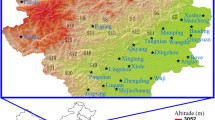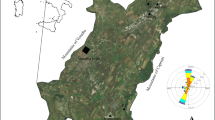Abstract
This study is a continuation of our preceding research identifying suitable environmental samples for the tracing of atmospheric pollution in industrial areas. Three additional types of environmental samples were used to characterise contamination sources in the industrial area of Ostrava city, Czech Republic. The region is known for its extensive metallurgical and mining activities. Fingerprinting of stable Pb isotopes was applied to distinguish individual sources of anthropogenic Pb. A wide range of 206Pb/207Pb ratios was observed in the investigated samples: 206Pb/207Pb = 1.168–1.198 in mosses; 206Pb/207Pb = 1.167–1.215 in soils and 206Pb/207Pb = 1.158–1.184 in tree cores. Black and brown coal combustion, as well as metallurgical activities, is the two main sources of pollution in the area. Fossil fuel burning in industry and households seems to be a stronger source of Pb emissions than from the metallurgical industry. Concentration analyses of tree rings showed that a significant increase in As concentrations occurred between 1999 and 2016 (from 0.38 mg kg−1 to 13.8 mg kg−1). This shift corresponds to the use of brown coal from Bílina, Czech Republic, with an increased As concentration. The burning of low-quality fuels in households remains a problem in the area, as small ground sources have a greater influence on the air quality than do industrial sources.







Similar content being viewed by others
References
Abouchami, W., & Zabel, M. (2003). Climate forcing of the Pb isotope record of terrigenous input into the equatorial Atlantic. Earth and Planetary Science Letters, 213(3–4), 221–234.
Ares, A., et al. (2015). Active biomonitoring with the moss Pseudoscleropodium purum: comparison between different types of transplants and bulk deposition. Ecotoxicology and Environmental Safety, 120, 74–79.
Bargagli, R., et al. (2002). Mosses and lichens as biomonitors of trace metals. A comparison study on Hypnum cupressiforme and Parmelia caperata in a former mining district in Italy. Environmental Pollution, 116(2), 279–287.
Berg, T., & Steinnes, E. (1997). Use of mosses (Hylocomium splendens and Pleurozium schreberi) as biomonitors of heavy metal deposition: from relative to absolute deposition values. Environmental Pollution, 98(1), 61–71 Available at: http://linkinghub.elsevier.com/retrieve/pii/S0269749197001036 [Accessed June 15, 2016].
Bindler, R., et al. (2004). Tree rings as Pb pollution archives? A comparison of 206Pb/207Pb isotope ratios in pine and other environmental media. Science of the Total Environment, 319(1–3), 173–183.
Blažek, Z. et al. (2013). Vliv Meteorologických Podmínek Na Kvalitu Ovzduší V Přeshraniční Oblasti Slezska a Moravy.
Doležalová Weissmannová, H., Pavlovský, J., & Chovanec, P. (2015). Heavy metal contaminations of urban soils in Ostrava, Czech Republic: assessment of metal pollution and using principal component analysis. International Journal Environmental Research, 9(2), 683–696.
Dudka, S., et al. (1996). Forms of Cu, Ni, and Zn in soils of Sudbury, Ontario and the metal concentrations in plants. Water, Air, and Soil Pollution, 90(3–4), 531–542 Available at: http://www.springerlink.com/app/home/contribution.asp?wasp=f62clceqlkcutge0eaak&referrer=parent&backto=issue,12,14;journal,5,190;browsepublicationsresults,2361,2418 [Accessed June 15, 2016].
Epelde, L., et al. (2012). Impact of sources of environmental degradation on microbial community dynamics in non-polluted and metal-polluted soils. Science of the Total Environment, 433, 264–272.
Ettler, V., et al. (2006). Geochemical and Pb isotopic evidence for sources and dispersal of metal contamination in stream sediments from the mining and smelting district of Příbram, Czech Republic. Environmental Pollution, 142(3), 409–417.
Figueira, R., Sérgio, C., & Sousa, A. J. (2002). Distribution of trace metals in moss biomonitors and assessment of contamination sources in Portugal. Environmental Pollution, 118(1), 153–163.
Francová, A., Chrastný, V., Šillerová, H., Vítková, M., Kocourková, J., & Komárek, M. (2017). Evaluating the suitability of different environmental samples for tracing atmospheric pollution in industrial areas. Environmental Pollution, 220, 286–297.
Galuskova, I., et al. (2014). Lead isotope composition and risk elements distribution in urban soils of historically different cities Ostrava and Prague, the Czech Republic. Journal of Geochemical Exploration, 147(PB), 215–221 Available at: http://linkinghub.elsevier.com/retrieve/pii/S0375674214000867.
Grodzińska, K., & Szarek-Łukaszewska, G. (2001). Response of mosses to the heavy metal deposition in Poland—an overview. Environmental Pollution, 114(3), 443–451.
Klaminder, J., et al. (2003). Isotopic trends and background fluxes of atmospheric lead in northern Europe: analyses of three ombrotrophic bogs from south Sweden. Global Biogeochemical Cycles, 17(1), 1019.
Klaminder, J., et al. (2005). Uptake and recycling of lead by boreal forest plants: quantitative estimates from a site in northern Sweden. Geochimica et Cosmochimica Acta, 69(10), 2485–2496.
Klaminder, J., Farmer, J. G., & Mackenzie, A. B. (2011). The origin of lead in the organic horizon of tundra soils: atmospheric deposition, plant translocation from the mineral soil or soil mineral mixing? Science of the Total Environment, 409(20), 4344–4350.
Komárek, M., et al. (2008). Lead isotopes in environmental sciences: a review. Environment International, 34(4), 562–577.
Konieczyński, J., Zajusz-Zubek, E., & Jabłońska, M. (2012). The release of trace elements in the process of coal coking. The Scientific World Journal, 2012, 1–8 Available at: http://www.hindawi.com/journals/tswj/2012/294927/.
Kunstmann, F. H., & Bodenstein, L. B. (1961). The arsenic content of South African coals. Journal of the South African Institute of Mining and Metallurgy, 62, 234–244.
Lee, C. S. L., et al. (2005). Biomonitoring of trace metals in the atmosphere using moss (Hypnum plumaeforme) in the Nanling Mountains and the Pearl River Delta, southern China. Atmospheric Environment, 39(3), 397–407.
Loppi, S., & Bonini, I. (2000). Lichens and mosses as biomonitors of trace elements in areas with thermal springs and fumarole activity (Mt. Amiata, central Italy). Chemosphere, 41(9), 1333–1336 Available at: http://linkinghub.elsevier.com/retrieve/pii/S0045653500000266.
Mihaljevič, M., et al. (2008). A comparison of tree rings and peat deposit geochemical archives in the vicinity of a lead smelter. Water, Air, and Soil Pollution, 188(1–4), 311–321.
Mihaljevič, M., et al. (2009). Isotopic composition of lead in Czech coals. International Journal of Coal Geology, 78(1), 38–46.
Morton-Bermea, O., et al. (2011). Lead isotopes as tracers of anthropogenic pollution in urban topsoils of Mexico City. Chemie der Erde - Geochemistry, 71(2), 189–195 Available at: http://linkinghub.elsevier.com/retrieve/pii/S0009281911000304.
Novak, M., et al. (2010). Radial distribution of lead and lead isotopes in stem wood of Norway spruce: a reliable archive of pollution trends in Central Europe. Geochimica et Cosmochimica Acta, 74(15), 4207–4218.
Novák, M., Emmanuel, S., Vile, M. A., Erel, Y., Véron, A., Pačes, T., et al. (2003) Origin of lead in eight central european peat bogs determined from isotope ratios, strengths, and operation times of regional pollution sources. Environmental Science & Technology, 37(3), 437–445.
Pešek, J., & Sivek, M. (2012). Uhlonosné pánve a ložiska černého a hnědého uhlí České republiky.
Qing, X., Yutong, Z., & Shenggao, L. (2015). Assessment of heavy metal pollution and human health risk in urban soils of steel industrial city (Anshan), Liaoning, Northeast China. Ecotoxicology and Environmental Safety, 120, 377–385.
Reimann, C., et al. (2001). Influence of extreme pollution on the inorganic chemical composition of some plants. Environmental Pollution, 115(2), 239–252.
Reimann, C., et al. (2012). Lead and lead isotopes in agricultural soils of Europe—the continental perspective. Applied Geochemistry, 27(3), 532–542.
Reimann, C., et al. (2016). Pb concentrations and isotope ratios of soil O and C horizons in Nord-Trøndelag, central Norway: anthropogenic or natural sources? Applied Geochemistry, 74, 56–66 Available at: http://linkinghub.elsevier.com/retrieve/pii/S0883292716302918 [Accessed November 25, 2016].
Sakalys, J., et al. (2009). Changes in total concentrations and assessed background concentrations of heavy metals in moss in Lithuania and the Czech Republic between 1995 and 2005. Chemosphere, 76(1), 91–97.
Sterckeman, T., et al. (2006). Trace element distributions in soils developed in loess deposits from northern France. European Journal of Soil Science, 57(3), 392–410.
Suchara, I., et al. (2011). The performance of moss, grass, and 1- and 2-year old spruce needles as bioindicators of contamination: a comparative study at the scale of the Czech Republic. Science of the Total Environment, 409(11), 2281–2297.
Sucharová, J., et al. (2014). Contemporary lead concentration and stable lead isotope ratio distribution in forest moss across the Czech Republic. Applied Geochemistry, 40, 51–60.
Sucharová, J., et al. (2011). Spatial distribution of lead and lead isotopes in soil B-horizon, forest-floor humus, grass (Avenella flexuosa) and spruce (Picea abies) needles across the Czech Republic. Applied Geochemistry, 26(7), 1205–1214.
Sucharová, J., & Suchara, I. (1998). Atmospheric deposition levels of chosen elements in the Czech Republic determined in the framework of the International Bryomonitoring Program 1995. Science of the Total Environment, 223(1), 37–52.
Tommasini, S., Davies, G. R., & Elliott, T. (2000). Lead isotope composition of tree rings as bio-geochemical tracers of heavy metal pollution: a reconnaissance study from Firenze, Italy. Applied Geochemistry, 15(7), 891–900.
USEPA (2007). Method 3051A: microwave assisted acid digestion of sediments, sludges, soils, and iols. In Cambridge University Press, pp. 1–30. Available at: http://www.epa.gov/osw/hazard/testmethods/sw846/pdfs/3051a.pdf.
USEPA (1996). Method 3052: microwave assisted acid digestion of siliceous and organically based matrices, pp.1–20.
Vejvoda, J., Buryan, P., & Svrček, P. (1998). Desulphurisation of waste gases in Czech republic. Acta Montanistica Slovaca, 3(3), 262–266.
Veron, A., et al. (1999). Isotopic evidence of pollutant lead sources in northwestern France. Atmospheric Environment, 33(20), 3377–3388.
Vuković, G., et al. (2015). Biomagnetic monitoring of urban air pollution using moss bags (Sphagnum girgensohnii). Ecological Indicators, 52, 40–47. Available at: http://linkinghub.elsevier.com/retrieve/pii/S1470160X14005536.
Watmough, S. A. (1999). Monitoring historical changes in soil and atmospheric trace metal levels by dendrochemical analysis. Environmental Pollution, 106(3), 391–403.
Watmough, S. A., & Hutchinson, T. C. (2003). Uptake of 207Pb and 111Cd through bark of mature sugar maple, white ash and white pine: a field experiment. Environmental Pollution, 121(1), 39–48.
Zuna, M., et al. (2011). Recent lead deposition trends in the Czech Republic as recorded by peat bogs and tree rings. Atmospheric Environment, 45(28), 4950–4958.
Acknowledgments
The research leading to these results has received funding from the Norwegian Financial Mechanism 2009–2014 under project contract no. 7F14330. This work was supported by Czech University of Life Sciences Prague (project IGA 4240013123161 and project CIGA 20164201). We would like to thank to the Elsevier language services for English corrections. Authors would like to thank two anonymous reviewers for their suggestions and comments.
Author information
Authors and Affiliations
Corresponding author
Additional information
Highlights
- Tree rings serve as historical evidence for changes of contamination sources.
- Use of coal is a stronger pollution source than metallurgical activities.
- Combustion in households is a significant source of pollution.
Electronic supplementary material
ESM 1
(PDF 12 kb)
Rights and permissions
About this article
Cite this article
Francová, A., Chrastný, V., Šillerová, H. et al. Suitability of selected bioindicators of atmospheric pollution in the industrialised region of Ostrava, Upper Silesia, Czech Republic. Environ Monit Assess 189, 478 (2017). https://doi.org/10.1007/s10661-017-6199-5
Received:
Accepted:
Published:
DOI: https://doi.org/10.1007/s10661-017-6199-5




